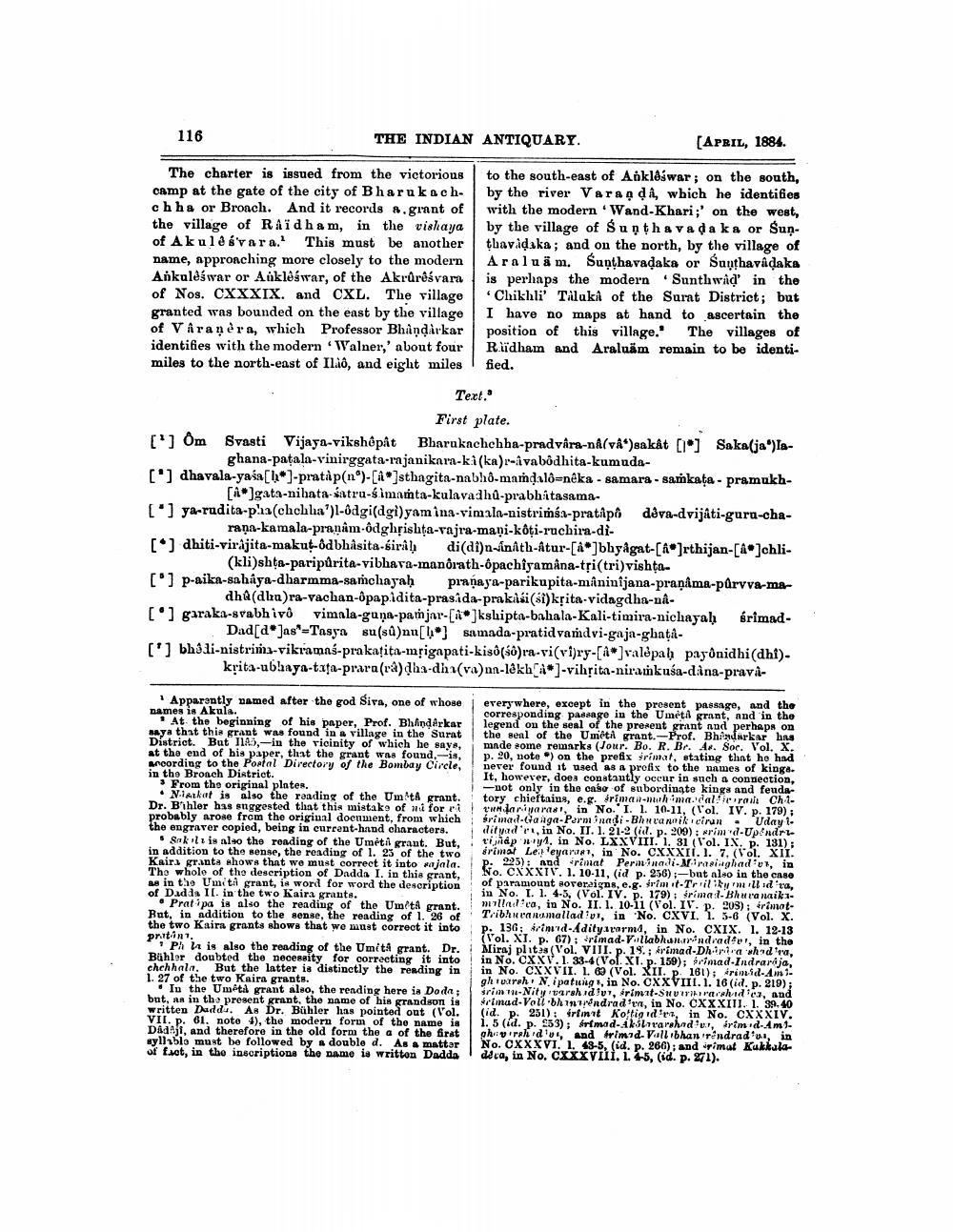________________
116
THE INDIAN ANTIQUARY.
The charter is issued from the victorious camp at the gate of the city of Bharukachchha or Broach. And it records a.grant of the village of Raidham, in the vishaya of Akulêsvara. This must be another name, approaching more closely to the modern Ankulêśwar or Aüklêśwar, of the Akrûrêśvara of Nos. CXXXIX. and CXL. The village granted was bounded on the east by the village of Varanera, which Professor Bhandarkar identifies with the modern Walner,' about four miles to the north-east of Ilàô, and eight miles
Text."
First plate.
[] Om Svasti Vijaya-vikshêpât Bharukachchha-pradvara-na(vâ*)sakât [1] Saka(ja")Iaghana-patala-vinirggata-rajanikara-ki (ka)r-avabodhita-kumuda
[] dhavala-yasa[*]-pratap(n°)-[*]sthagita-nabhô-mamdalô-nêka - samara - samkata - pramukh[A]gata-nihata-satru-simamta-kulavadhû-prabhatasama
[]
ya-rudita-pha(chchha')l-ôdgi(dgi)yamina-vimala-nistrimsa-pratapô rana-kamala-pranam-ôdghṛishta-vajra-mani-kôti-ruchira-di
dêva-dvijâti-guru-cha
Apparently named after the god Śiva, one of whose names is Akula.
[APRIL, 1884.
to the south-east of Anklêswar; on the south, by the river Varanda, which he identifies with the modern Wand-Khari;' on the west, by the village of Sunthavada ka or Sunthavadaka; and on the north, by the village of Aralum. Sunthavadaka or Sunthavadaka is perhaps the modern Sunthwid' in the 'Chikhli' Taluk of the Surat District; but I have no maps at hand to ascertain the position of this village." The villages of Ridham and Araluäm remain to be identified.
[]
[] dhiti-virajita-makut-ôdbhâsita-sirab di(di)n-AnAth-Atur-[*]bhyagat-[*]rthijan-[4]chli(kli)shta-paripurita-vibhava-manôrath-ôpachiyamâna-tri (tri) vishta. p-aika-sahaya-dharmma-samchayah pranaya-parikupita-mâninijana-pranama-pûrvva-madha (dha)ra-vachan-ôpapidita-prasida-prakasi (si)krita-vidagdha-nagaraka-svabhivo vimala-guna-pamjar-[a]kshipta-bahala-Kali-timira-nichayah Dad[d Jas"-Tasya su(sû)nu[b] samada-pratid vaṁdvi-gaja-ghata[] bholi-nistrima-vikramas-prakatita-mrigapati-kisô(so)ra-vi(vi)ry-[*]valèpah payônidhi (dhi)
[]
śrimad
krita-bhaya-ta-prara(cd)dha-dha(va)nn-Mich[A]-vihrita-niramkuin-dina-pravà
a
everywhere, except in the present passage, and the corresponding passage in the Umetà grant, and in the legend on the seal of the present grant and perhaps on the seal of the Umêtà grant.-Prof. Bhandarkar has made some remarks (Jour. Bo. R. Br. As. Soc. Vol. X. p. 20, note) on the prefix srimat, stating that he had never found it used as a profix to the names of kinga. It, however, does constantly occur in such a connection, -not only in the case of subordinate kings and feuda tory chieftains, e.g. riman-mahima daliera Chivundariyaras, in No. I. 1. 10-11, (Vol. IV. p. 179); srimad-Ganga-Permnadi-Bhuvannik eiran Uday dityad', in No. II. 1. 21-2 (id. p. 209): srimd-Upendr tiap 4, in No. LXXVIII. 1. 31 (Vol. IX. p. 131); srimat Leeyaras, in No. CXXXII. 1. 7. (Vol. XII. p. 225): and v, in No. CXXXIV. 1. 10-11, (id p. 256);-but also in the case of paramount sovereigns, e.g. śrimit-Trilky mll diva, in No. I. 1. 4-5, (Vol. IV. p. 179); śrimad-Bhuvanaikmallad ca, in No. II. 1. 10-11 (Vol. IV. p. 208): rimatTribhuvanamallad v1, in No. CXVI. 1. 5-6 (Vol. X. p. 136: Artmid-Adityavarm4, in No. CXIX. 1. 12-13 (Vol. XI. p. 67); rimad-Vallabhanarendrade, in the Miraj plites (Vol. VIII. p. 15.; krimad-Dhirra shed'ra, in No. CXXV. 1. 33-4(Vol. XI. p. 159); rimad-Indraraja, in No. CXXVII. 1. 63 (Vol. XII. p. 161); rimid-Amghwarah N. ipatung, in No. CXXVIII. 1. 16 (id. p. 219); srimu-Nity warshidiu, irimat-Suvirrashidea, and Srimad-Voll bhimrendraden, in No. CXXXIII. 1. 39.40 (id. p. 251): irtit Kotigidir, in No. CXXXIV. 1.5 (id. p. 253); rimad-Akslavarshade, irim d-Amghav rahide, and trimed. Vall bhan rendrad', in No. CXXXVI. 1. 43-5, (id. p. 266); and rimat Kukkaladeca, in No. CXxxviii. 1. 4-5, (id. p. 271).
At the beginning of his paper, Prof. Bhandarkar saya that this grant was found in a village in the Surat District. But I,-in the vicinity of which he says, at the end of his paper, that the grant was found.is, according to the Postal Directory of the Bombay Circle, in the Broach District.
3 From the original plates.
Niarkat is also the reading of the Umt grant. Dr. Bihler has suggested that this mistake of ni for ei probably arose from the original document, from which the engraver copied, being in current-hand characters.
4
Sakl is also the reading of the Umêtà grant. But, in addition to the sense, the reading of 1. 23 of the two Kaira grants shows that we must correct it into sajala. The whole of the description of Dadda I. in this grant, as in the Umità grant, is word for word the description of Dadda II. in the two Kaira grants.
Pratipa is also the reading of the Umetà grant. But, in addition to the sense, the reading of 1. 26 of the two Kaira grants shows that we must correct it into pratin
Phla is also the reading of the Umitâ grant. Dr. Bühler doubted the necessity for correcting it into chchhala. But the latter is distinctly the reading in 1. 27 of the two Kaira grants.
In the Umetà grant also, the reading here is Doda; but, as in the present grant, the name of his grandson is written Dadds. As Dr. Bühler has pointed out (Vol. VII. p. 61. note 4), the modern form of the name is Dadaji, and therefore in the old form the a of the first syllable must be followed by a double d. As a matter of fact, in the inscriptions the name is writton Dadda




